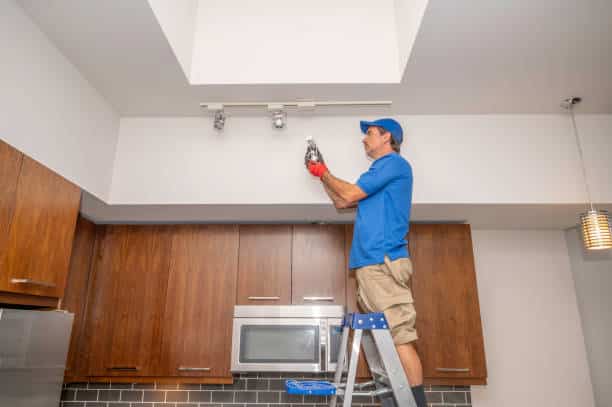Upgrading our living spaces not only enhances the aesthetics but can also lead to long-term cost savings. Surprisingly, many home improvements don’t require a huge investment. With a little bit of innovation, resourcefulness, and a hands-on approach, homeowners can achieve substantial savings through some smart upgrades. Here, we delve into cost-effective home enhancements that not only revamp your home but also your savings account.
- Energy-Efficient Window Installations
Return on Investment: A study indicates that switching to energy-efficient windows can save homeowners between $125 to $465 annually.
How to Implement: Search for double-paned windows or those with an Energy Star rating. The initial investment might seem hefty, but the savings in energy bills and increased property value can be significant in the long run.
- LED Lighting Overhaul
Return on Investment: LEDs consume 75% less energy than incandescent bulbs and last 25 times longer!
How to Implement: Begin by replacing frequently used bulbs with LED counterparts. Over time, transition all bulbs in your home. Also, consider motion sensor lights for areas like hallways or closets to cut down on unnecessary usage.
- Water-Saving Fixtures
Return on Investment: Cutting down water consumption doesn’t just reduce water bills but also decreases costs associated with heating water.
How to Implement: Invest in low-flow showerheads, faucets, and toilets. Catching and fixing leaks promptly can also save gallons of water, translating to savings in your pocket.
- Programmable Thermostats
Return on Investment: Homeowners can save up to $180 per year by properly setting their programmable thermostats and maintaining those settings.
How to Implement: Choose a thermostat that fits your schedule. Set it to decrease heating or cooling efforts when you’re away or asleep, and kick it back on just before you arrive home or wake up.
- Insulation Boost
Return on Investment: A well-insulated home can save up to 20% on heating and cooling costs or up to 10% on the total annual energy bill.
How to Implement: Start with the attic, as it’s often the source of most heat loss. Next, insulate basements and crawl spaces. Even simple measures like draft guards under doors can make a huge difference.
- “Cut My Plastic” and Other Eco-friendly Practices
Return on Investment: Implementing eco-friendly practices can result in reduced utility bills, possible tax credits, and an increase in home value.
How to Implement:
- Cut My Plastic: Invest in durable, reusable items made from sustainable materials. For instance, instead of buying a plastic cutting board that might warp or crack, opt for a bamboo one. The phrase “Cut my plastic” isn’t just about literal plastic items. It’s a mindset of choosing sustainable, durable items over disposable, often plastic-based, ones.
- Solar Panels: Although an upfront investment, many homeowners break even within 7-8 years, after which they effectively have free electricity!
- Landscaping: Plant shade trees strategically around your property. They can cool your home in summer, reducing the need for air conditioning, and act as a windbreak in winter, cutting down on heating costs.
- Smart Home Devices
Return on Investment: These devices might seem like luxury items, but many lead to long-term cost savings.
How to Implement:
- Smart Plugs: Connect devices to these plugs, and you can control them via smartphone. You won’t have to wonder if you left the iron on ever again.
- Home Energy Monitors: These devices provide real-time data on your home’s energy consumption, making it easier to spot and rectify energy-wasting habits.
- Upcycling and DIY
Return on Investment: Creating something new from old items or doing a project yourself can save a ton compared to buying new or hiring out.
How to Implement: Before discarding old furniture, see if it can be repurposed. Old wooden ladders can become bookshelves, and worn-out dressers can be transformed into kitchen islands. There are a plethora of DIY tutorials online to guide you.
- Repaint and Refresh
Return on Investment: A fresh coat of paint can instantly rejuvenate a space, adding value to your home without a massive expenditure.
How to Implement: Opt for neutral, light-reflecting colors that can make spaces look larger and more inviting. Furthermore, painting can be a DIY project, saving labor costs. Consider eco-friendly paints that don’t emit harmful VOCs, ensuring a safer indoor environment for your family. For exterior spaces, choose paints specifically designed for weather resistance to ensure longevity.
- Upgrade Door and Cabinet Hardware
Return on Investment: Small hardware changes can have a considerable impact on the look and feel of rooms, especially kitchens and bathrooms, which are prime spaces that potential buyers inspect if you’re considering reselling.
How to Implement: Instead of undergoing a full kitchen remodel, try changing out old cabinet knobs and pulls for modern, stylish ones. The same goes for doors throughout your home. Upgrading handles or knobs can give them a fresh, updated appearance. Keep consistency in mind for a cohesive look, and shop around for deals to ensure you’re getting the best bang for your buck.
Incorporating Value with Thoughtfulness
Making cost-effective upgrades is as much about creativity as it is about research and investment. It’s about seeing potential in what you have and understanding where strategic investments can be made. Whether you’re “cutting your plastic” or simply adding a splash of new paint, remember that every thoughtful change contributes to a home that’s both beautiful and economically smart.
Conclusion
Upgrading your home doesn’t always mean breaking the bank. With these cost-effective enhancements, you can significantly improve your living space and save money in the long run. The key is to view your home as an evolving entity, one that, with a bit of creativity and effort, can lead to “savings beyond imagination”.





